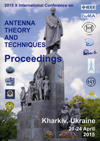Method of self-recovery for sensory communication system using spatial-selective antennas
DOI:
https://doi.org/10.1109/ICATT.2015.7136863Keywords:
sensory networks, self-organization, spatial selectivity, antennas, directional patternAbstract
Sensory network properties of self-organization and self-recovery are complemented with the property of spatial selectivity possess wider abilities. They facilitate search and positioning of an interacting station and promote the increase in the range of coverage.References
SUBRAMANIAN, L.; KATZ, R.H. An architecture for building self-configurable systems. Proc. of Mobile Ad Hoc Network Comput. Workshop, 2000, Boston, MA. IEEE, 2000, p.63-73, doi: http://dx.doi.org/10.1109/MOBHOC.2000.869214.
ROY, R.H. An overview of smart antenna technology and its application on wireless communication system. Proc. of IEEE Conf. on Personal Wireless Copp., 2007, p.234-238.
BENCINI, LUCA; COLLODI, GIOVANNI; DI PALMA, DAVIDE; MANES, GIANFRANCO; MANES, ANTONIO. An Energy Efficient Cross Layer Solution based on Smart Antennas for Wireless Sensor Network Applications. Proc. of 4th IEEE Int. Conf. on Sensor Technologies and Applications, 18-25 Jul. 2010, Venice. IEEE, 2010, p.232-237, doi: http://dx.doi.org/10.1109/SENSORCOMM.2010.43.

